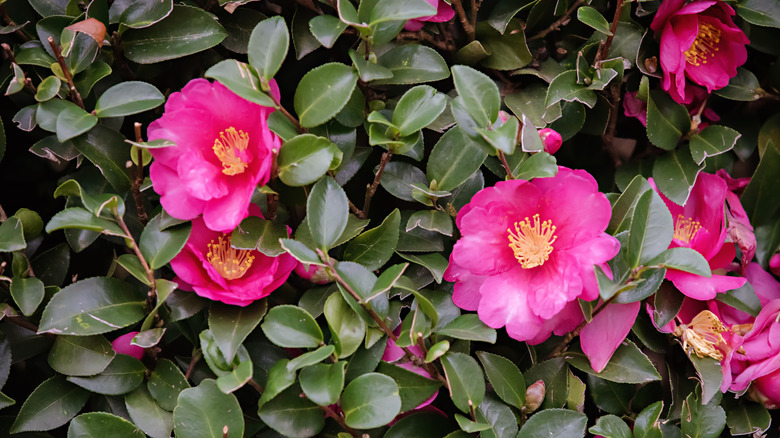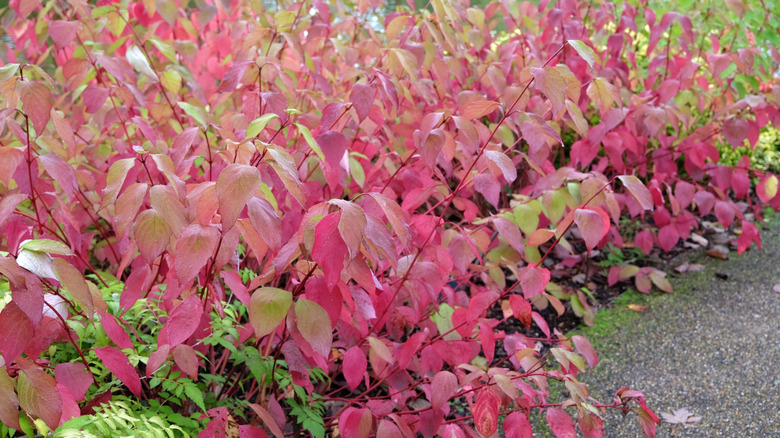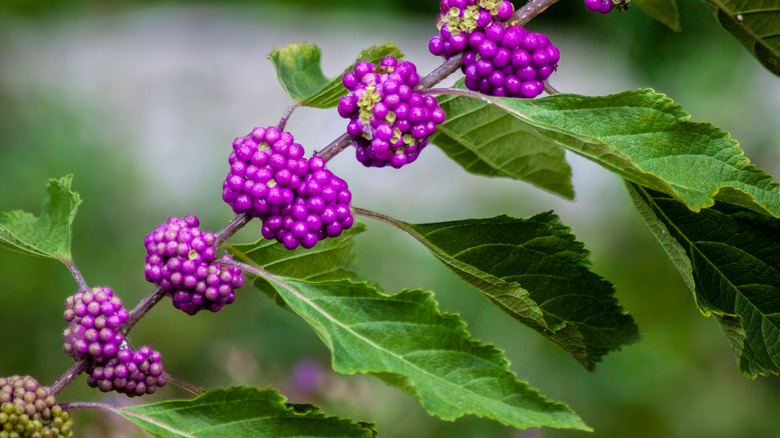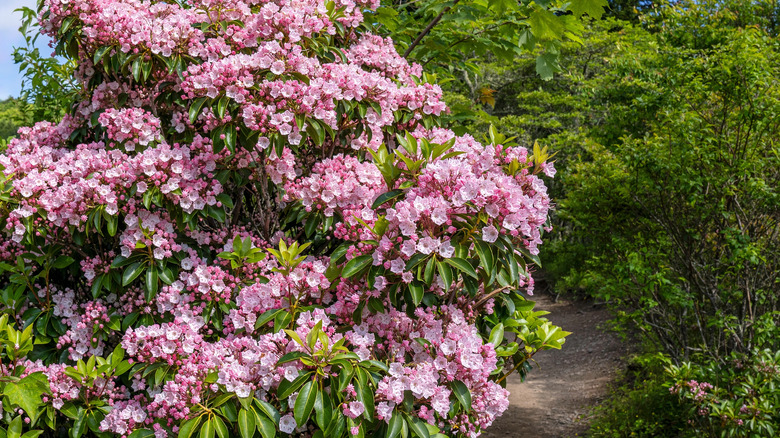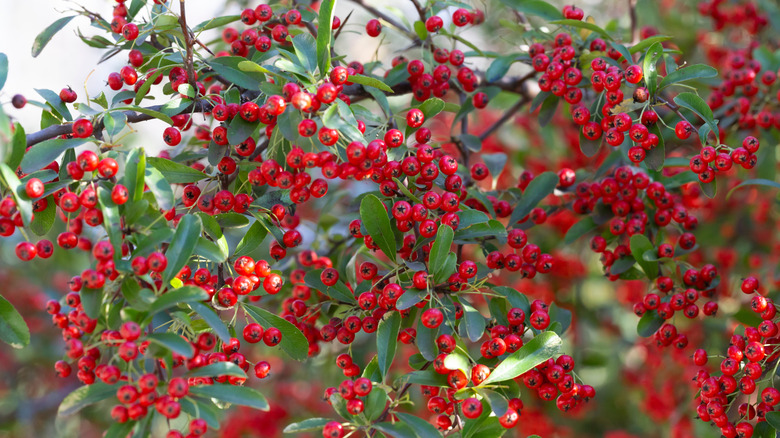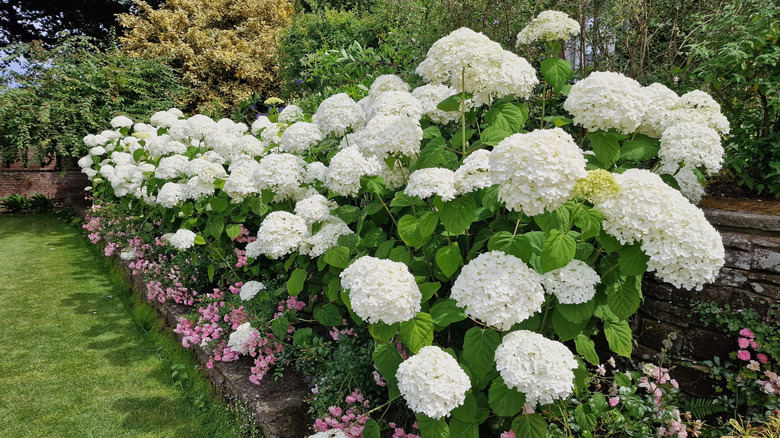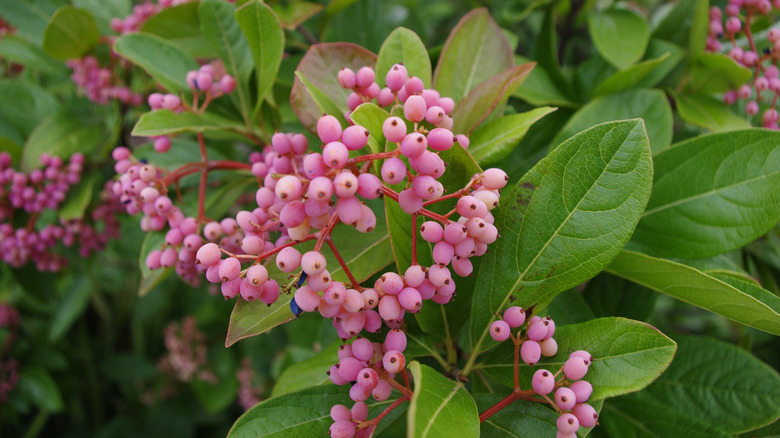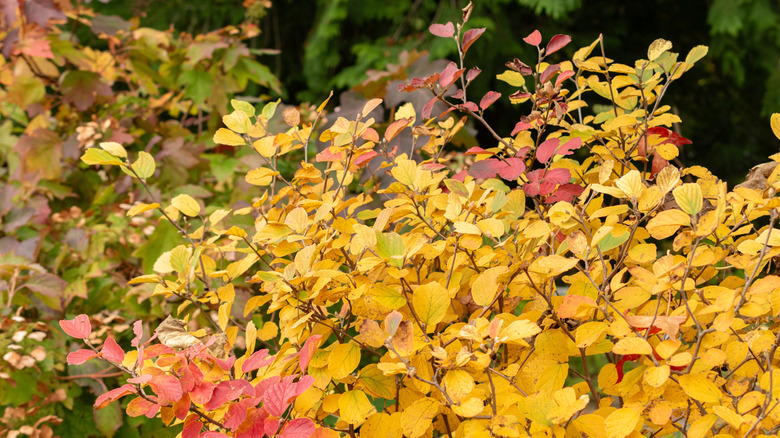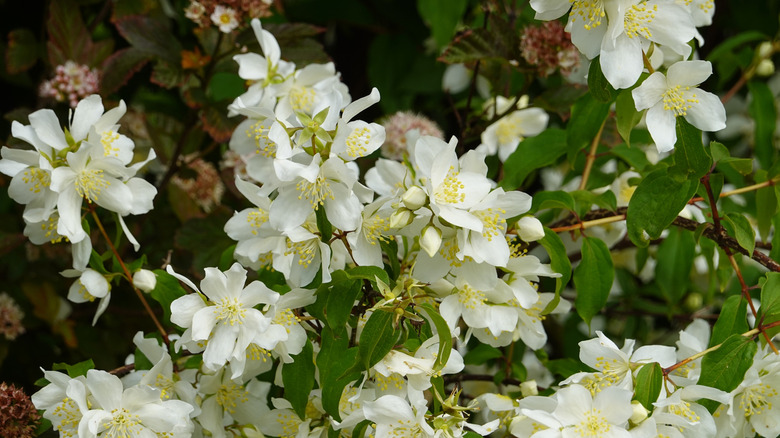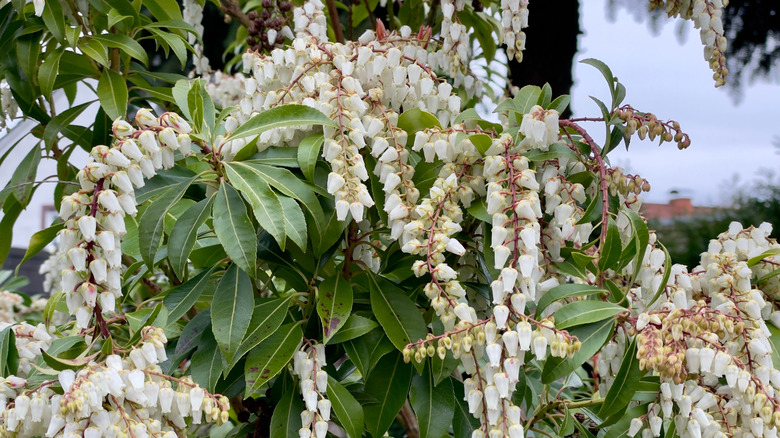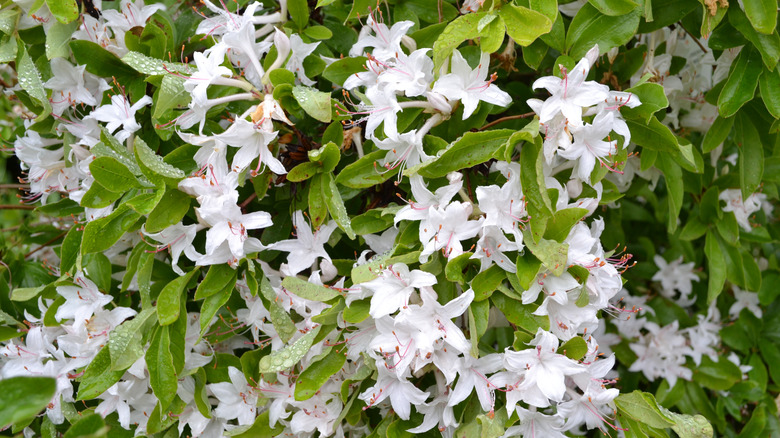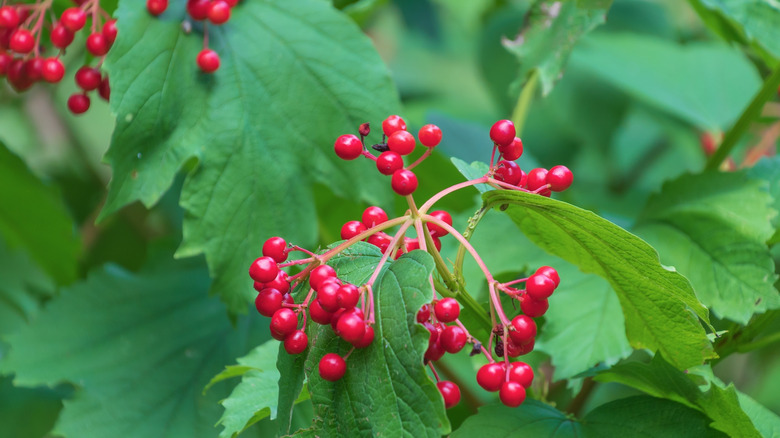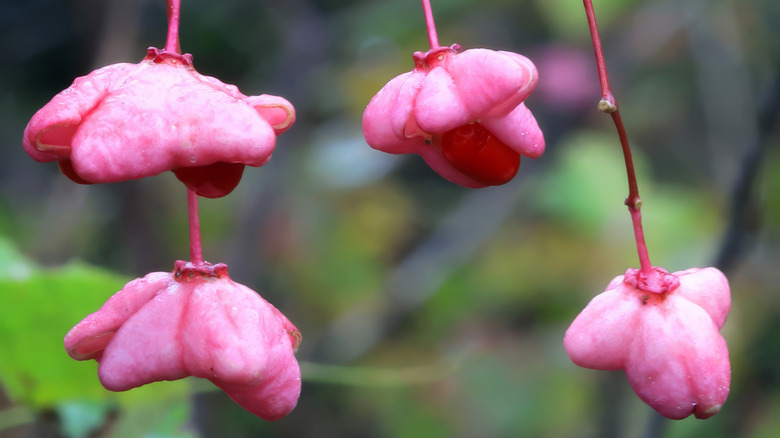Native Shrubs That Add Color In Every Season
You step outside to marvel at your landscape, trying to enjoy its beauty before the season ends. While some shrubs only bring a splash of color with bold flowers in the summer or showy berries in the fall, several native species provide year-round interest, elevating your yard for more than just a few months. It's not just vibrant blooms or bright berries that can add color to your garden. Some shrubs have striking red branches, stunning fall foliage, or textured winter bark. Each of the plants listed below will provide visual interest, no matter which season it is.
The benefits of planting native shrubs in your yard extend far past aesthetics. They support local wildlife by providing food sources and shelter that birds, butterflies, bees, and other beneficial insects and animals rely on to survive. In contrast, nonnative shrubs fail to support nearly as many species, often providing little to no food or habitat for local wildlife and, in some cases, outcompeting native plants.
Unfortunately, many popular landscaping shrubs, like the invasive burning bush (Euonymus alatus), are aggressive growers that can displace native species. Fortunately, there are plenty of beautiful alternatives that enhance your landscape throughout the seasons while benefiting wildlife.
Red twig dogwood
It's hard to beat all the ways the red twig dogwood (Cornus sericea) showcases its beauty throughout the year. Most notably, this shrub features pretty red stems that become even more vibrant in winter, contrasting beautifully against a fresh, white snowfall. By mid-to-late spring, it reveals its clusters of tiny, creamy-white flowers that butterflies and bees love. Its blooms are followed by white drupes that appear during summer, which some say are even prettier than the flowers. Songbirds love its fruit, and many species use the dense thickets for nest-building. Its medium to dark green foliage begins fading to reddish or orangish before turning an attractive shade of purple in the fall.
Red twig dogwood is native to most of North America and is commonly found in wetlands and along riverbanks across the northern U.S. and Canada. This showy shrub can thrive in swampy conditions, making it the perfect choice for a working rain garden. Hardy in U.S. growing zones 2 through 7, hot summer temperatures can cause it to become stressed. It can tolerate several soil types, though it prefers organically rich, neutral to alkaline, well-drained blends and grows best in full sun to partial shade. Water regularly to keep the soil consistently moist, especially during hot periods. Typically growing 6 to 9 feet tall and wide, you can use these shrubs to create hedges or plant them individually as specimen plantings.
American beautyberry
It's no surprise that a plant with beauty in its name is one of the most beautiful native plants for landscaping. In the fall, the stems of American beautyberry (Callicarpa americana) become covered in bright bluish or purplish fruit that often persist through winter. Not only is the fruit edible for humans, but songbirds like purple finches, American robins, and brown thrashers also enjoy snacking on it. In late spring and summer, clusters of small blue, pink, purple, or white flowers appear along the stems. While many beneficial insects and animals find food and shelter on this shrub, crushing its leaves releases a chemical that can repel harmful pests like ticks, mosquitoes, and fire ants.
American beautyberry is native to the southeastern United States and can be found throughout the Atlantic and Gulf Coastal Plains. It's hardy in zones 6 through 12 and may die back in regions with harsh winters, though new growth will emerge from the base. Often found in meadows, woodlands, and water margins, this low-maintenance shrub can tolerate a variety of soil types, including dry or wet conditions, as long as it's well-drained. Although it can grow in part shade, its best fruiting occurs when planted in an area that receives full sun. Give it a good pruning in late winter to help promote flowers and fruit, which emerge from new growth. Once established, this shrub will be 3 to 8 feet tall and 3 to 6 feet wide.
Mountain laurel
Mountain laurel (Kalmia latifolia) is as valuable to the environment as it is stunning year-round. It's prized for its breathtaking clusters of white, pink, or rose five-sided cup-shaped flowers with interesting markings on the inside that appear in spring or summer. When a bee stops by one of these unique flowers, the anthers get triggered and rapidly release pollen, increasing the chance of successful pollination. Its unique flowers give way to brown fruit capsules in fall that last through winter. Although the fruit isn't particularly showy, this shrub makes up for it with its evergreen foliage that lasts all year.
This charming native was given the title of state flower of both Connecticut and Pennsylvania and naturally grows in various habitats across the eastern coast of the U.S., from southern Maine to Louisiana. You can grow mountain laurel in hardiness zones 4 to 9 in a range of light conditions. However, this shrub prefers partial sun with protection from the intense afternoon rays. It's best grown in fertile, acidic, well-drained, humusy soils and cannot tolerate heavy clay. Mountain laurel blooms on old wood, so prune immediately after the flowers have finished blooming. This slow-growing shrub typically reaches about 5 to 15 feet tall and wide.
Red chokeberry
Red chokeberry (Aronia arbutifolia) is another native shrub with fruits that are both visually appealing and edible. As the glossy green leaves from summer fade to a vibrant orange-red or purple in autumn, the bright, glossy red chokeberries begin to cover the shrub, persisting through winter. Its leaves will start to shed as temperatures drop, revealing its reddish bark that pairs nicely against a snowy winter landscape. When spring rolls around, showy clusters of white to pale pink flowers bloom, attracting butterflies, bees, and other pollinators who will enjoy them as much as you do.
Native to eastern North America, red chokeberry shrubs naturally grow in a variety of habitats, from swampy areas to dry woodland thicket, across parts of Canada, extending out to the northeastern U.S., like Maine and New York, to as far south as Florida and Texas. Hardy in zones 3 to 9, it blooms best in full sun, though it can tolerate partial sun. This shrub is also tolerant of nearly every soil type and can thrive even in wet conditions. Red chokeberry can become leggy as it ages, so consider using it in mass plantings or give it a yearly pruning, removing about one-third of its oldest stems. Your shrub will reach about 6 to 12 feet tall and 3 to 6 feet wide at maturity.
Smooth hydrangea
Hydrangeas are well-known for their large clusters of cloud-like blooms. One notable variety, the smooth hydrangea (Hydrangea arborescens), adds visual interest to your garden every season. In late spring or early summer, these eye-catching shrubs put out dense, fluffy flowerheads in shades of white, cream, pink, or green, depending on the cultivar. Their up to two-month blooming period will attract pollinators, like butterflies, to your garden. As flowers fade, smooth hydrangeas produce small, dry fruit capsules that ripen in autumn. Although not showy, they provide some added texture to the plant. If you choose to let the canes mature, the outer layers of bark will peel in thin strips, giving the stems an attractive rustic look. Although subtle, the textured bark provides added winter interest, especially when paired with dried flower heads.
Smooth hydrangeas are native to the eastern U.S., typically growing along streams, sloped forested regions, ravines, and bluff bases from New York to Florida, stretching to parts of the Midwest, Louisiana, and Oklahoma. You can grow hydrangeas in hardiness zones 3 to 9 in average, neutral to acidic, well-drained soils in full sun to partial shade. However, they'll need extra watering in full-sun areas. You can encourage stem growth by pruning them back in late winter, or you can let the bark age and remove weak, dead, or damaged stems in early spring. These small, bushy shrubs typically grow 3 to 5 feet tall and wide, making them useful in mixed borders or woodland gardens.
Coralberry
Pops of pink in your landscape aren't just for summer when you plant native shrubs like coralberry (Symphoricarpos orbiculatus). As colorful flowers in your garden fade, this shrub starts producing vibrant pink or purple berry-like drupes in autumn, adding a splash of color through winter. Dainty pale green flowers bloom through late spring to early summer, though the lush, bright green foliage is the real star of the show during warmer months. When leaves fade, they reveal the shrub's attractive shredded bark, which is particularly striking against white snow. Coralberry provides food and habitat for local wildlife, offering dense thickets for nesting birds, cover for small mammals, and leaves for hungry caterpillars.
Hardy in zones 2 to 7, coralberry is native to the eastern U.S. In nature, you may see this shrub growing in forested areas and along streambanks in several regions, from New York to Texas, as far west as Colorado. This shrub is easy to grow and tolerates an array of soil types, though it prefers neutral to alkaline, loamy or rocky well-drained blends. Plant coralberry in an area of your garden where it will receive partial to full sun. Use this suckering shrub to prevent erosion on slopes or in a naturalized garden. It typically reaches 2 to 4 feet tall and up to 6 feet wide at maturity.
Witch-alder
Witch-alder (Fothergilla) is a versatile shrub that offers four seasons of interest, starting with honey-scented, bottlebrush-like flowers that emerge in April or early May. Their fuzzy white blooms last for up to three weeks, providing nectar to pollinators like butterflies. In fall, they're replaced by brown fruits paired with leathery bluish-green leaves that birds use for cover. Its foliage provides stunning autumn color in rich shades of yellow, orange, or red, depending on the sunlight, rainfall, and temperature. In winter, the interesting zigzag branching habit and fan-like stem shape provide textural interest, especially when frosted with snow.
Fothergilla is a genus containing two species native to the southeastern U.S. Mountain witch-alder (Fothergilla major) is hardy in zones 4 to 8 and occurs naturally in wooded areas, ravines, and along stream banks in mountainous areas of Georgia, Alabama, and North Carolina. Dwarf witch-alder (Fothergilla gardenii), hardy in zones 5 through 8, is a slightly smaller version that naturally grows in coastal plain bogs and tropical grasslands in Alabama, the Florida panhandle, and up into North Carolina. Witch-alder grows best in full sun but can tolerate light shade and prefers rich, slightly acidic, and well-drained soils. Mountain witch-alder will grow 6 to 10 feet tall with a 5- to 9-foot spread, while the dwarf species only reach 1 ½ to 3 feet tall with a 2- to 4-foot spread. These shrubs are perfect for cottage or naturalized gardens and make a good foundation or border plant.
Wild mockorange
Wild mockorange (Philadelphus lewisii) provides a stunning floral display of white blossoms with yellow centers beginning in late spring or early summer. These gorgeous blooms attract hummingbirds to your yard, along with other pollinators like butterflies and bees. As it wraps up blooming, the petals fall away while the sepals remain, making it appear as though your shrub is covered in a different type of flower for an extended floral display. The soft green leaves that cover the shrub from spring to summer fade to an attractive yellow in the fall. In winter, buds emerge, adding textural interest alongside its attractive shredded bark.
These pretty shrubs are found in open woodlands, along stream banks, and in mountainous regions in southern British Columbia, down through northern California, and as far east as western Montana and up into Alberta. Wild mockorange is a low-maintenance plant that grows in hardiness zones 4 to 9 and thrives in full sun to part shade. It's tolerant of most soil types and conditions but prefers moist, well-drained soil. Although it can tolerate drought once established, occasional supplemental watering can help promote blooming and overall growth. In adulthood, it'll reach 5 to 12 feet tall with a similar spread and works well in borders or as a foundation plant.
Mountain Fetterbush
If you're looking for low-maintenance, year-round greenery, mountain fetterbush (Pieris floribunda) may be a great addition to your landscape. In spring, dense clusters of creamy white, urn-shaped flowers dangle gracefully from the stems and bloom into early summer. Their fragrant blooms are attractive to pollinators, making this an excellent plant to add if you're creating a garden to attract bees. As their flowers die off, their leathery, vibrant green leaves provide a lush backdrop in the garden that looks attractive, even without blooms. Attractive flower buds form in the fall, remaining erect through the winter.
Mountain fetterbush is a cold-hardy shrub native to the eastern U.S., commonly found on mountain slopes and in wooded areas throughout states along the Appalachians. Hardy in zones 4 to 6, this bushy evergreen thrives in cooler temperatures and doesn't tolerate heat and humidity. Although it prefers full to partial sun, it may need some protection from prolonged sunlight and wind during the winter. Plant in acidic, well-drained soil and keep the soil consistently moist, especially during prolonged dry periods. Once established, mountain fetterbush will be 4 to 6 feet tall and 3 to 4 feet wide. This versatile plant looks stunning in the yard, whether in mass plantings, as a specimen plant, or as a feature in a rock garden.
Sweet azalea
There's so much to love about sweet azalea (Rhododendron arborescens), from its delightful scent to its multi-season color. Showy white or pink-tinged flowers with contrasting red stamens blanket the shrub, typically from late spring to early summer, sometimes blooming as late as September. Sweet azaleas are like a buffet for hummingbirds; this shrub is a host plant to dozens of caterpillar species that provide an ideal protein source, and the funnel-shaped blooms provide easy access to nectar. In autumn, the green leaves turn to vibrant fall shades like bright orange, crimson, or purple, creating a breathtaking autumn landscape.
Hardy in zones 4 through 7, this rhododendron species is native to eastern North America and commonly grows along streambanks or woodland slopes as far north as New York, south to Georgia, and west through Mississippi, Kentucky, and Tennessee. Sweet azalea is a low-maintenance shrub that grows quickly, typically reaching 8 to 12 feet tall and wide, though it can grow up to 20 feet. It happily grows in dappled sun in acidic, sandy, well-drained soils. This flowering shrub looks stunning in a variety of garden types, from mixed borders to open shade gardens.
American cranberrybush
The American cranberrybush is a notable species within the Viburnum genus, particularly due to its showy fruit. The attractive clusters of bright red cranberry-like drupes appear in late summer to early fall and often persist throughout winter, creating a festive holiday scene. Small mammals and some songbirds, like robins and cedar waxwings, use their fruits for cold-season nutrition. Before the leaves fall from the shrub, they may turn an attractive purplish-red in autumn. In spring, pretty white lacecap flowers appear, attracting pollinators to the garden.
Native to northern North America, the American cranberrybush is hardy in zones 2 through 7 and commonly grows along lake margins, wooded hillsides, and slopes in the northern and upper midwestern U.S., extending into parts of Canada. It's easily grown in full sun to partial shade and prefers well-drained soil. Applying fertilizer at the start of the growing season will give it a boost of nutrients for better flowering and fruiting. This shrub will reach 8 to 12 feet tall and wide and is perfect for shrub borders, foundations, and woodland margins.
Eastern wahoo
Eastern wahoo (Euonymus atropurpureus) is a versatile landscape shrub that brings continuous color to your yard, from its spring blooms to its winter berries. Although sometimes referred to as burning bush, it's not to be confused with its non-native counterpart. Small clusters of purplish flowers appear in late spring and typically last for about a month. However, the main attraction is its picturesque bright red or burgundy four-pointed star-like fruits that emerge in the fall. During this time, the dark green leaves fade to shades ranging from yellow to vibrant reds that rival the colors of the invasive burning bush. The showy berries often persist through winter, standing out beautifully against the shrub's bare branches.
The eastern wahoo is native to central and southeastern parts of the U.S., commonly found in wooded areas and along riverbanks extending from New England to Florida and westward to Texas and Missouri. Hardy in zones 3 to 8, this shrub grows best in shady areas with dappled sunlight in fertile, moist, well-drained, loamy soil. However, it can withstand full sun and tolerates a variety of soil types, including clay and sand. It's a fast-growing species, reaching 12 to 25 feet tall and 15 to 25 feet wide, sometimes reaching small tree status. Use eastern wahoo to create a colorful hedge or as a specimen plant to create an autumn focal point.
